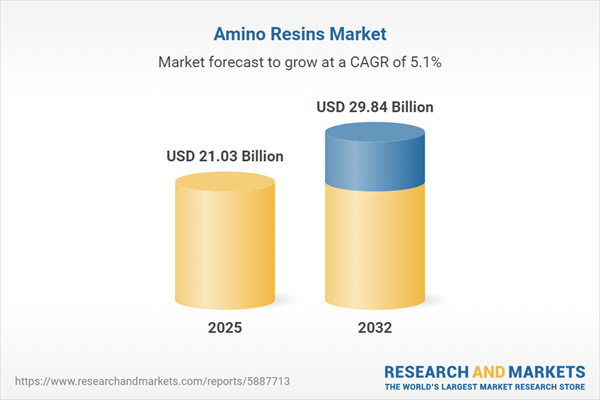Speak directly to the analyst to clarify any post sales queries you may have.
The amino resins market is advancing as industries demand improved performance, heightened compliance, and greater sustainability from manufacturing inputs. Senior executives face growing complexity and require dependable market knowledge to make strategic decisions and capture value across the amino resins value chain.
Market Snapshot: Amino Resins Market Growth and Trends
The amino resins market demonstrates robust expansion, rising from USD 20.00 billion in 2024 to USD 21.03 billion in 2025 and projected to reach USD 29.84 billion by 2032, reflecting a CAGR of 5.12%. This growth trajectory highlights amino resins’ pivotal role in sectors where advanced material performance and process efficiency are paramount. Sustained momentum is driven by innovation in sustainable formulations and the integration of new raw materials, particularly in adhesives and coatings for construction and automotive. Enhanced manufacturing technologies are establishing new expectations for product quality and regulatory compliance, while targeted investment across the sector continues to foster differentiation, value creation, and operational efficiency.
Amino Resins Market Scope & Segmentation
- Type: Melamine formaldehyde is available in both high-performance and standard grades, serving a range of industrial requirements. Phenolic resins, including novolac and resole types, address challenging operational environments. Urea formaldehyde meets both standard and low-emission standards, offering options for safety-sensitive applications.
- Application: Adhesives support the manufacture of core panelboards like MDF, particleboard, and plywood. Coatings enhance automotive, wood, and industrial product performance. Insulation technologies provide solutions for building thermal management and electrical safety. Molding compounds are used in the automotive, decorative laminate, and electronics sectors. Textile applications include carpet backing and coatings for technical fabrics.
- End Use: Automotive, construction, electrical and electronics, and wood processing segments depend on amino resins for customized performance and enhanced reliability.
- Product Form: Liquid, powder, and solid amino resins simplify manufacturing integration, support automation, and improve adaptability across various industry settings.
- Geographic Coverage: The market encompasses the Americas (including the United States, Canada, Mexico, and Latin America), Europe, the Middle East and Africa (notably the United Kingdom, Germany, France, and Russia), and the Asia-Pacific region (including China, India, Japan, South Korea, Australia, and Southeast Asia).
- Key Companies: Industry leaders such as Hexion Inc., BASF SE, Kolon Industries, DIC Corporation, Mitsubishi Gas Chemical Company, Toray Industries, Synthomer PLC, and Sika AG drive sector progress with technical proficiency and reliable supply networks.
Key Takeaways for Senior Decision-Makers
- Thermosetting amino resins form the foundation for advanced adhesives, coatings, insulation materials, and molding compounds, with process and raw material developments continually shaping sector capabilities.
- The adoption of bio-based ingredients and digital manufacturing methods is supporting sustainable development and more predictable supply for end-user industries.
- Evolving regulatory requirements, especially emissions controls, steer research and development toward safer chemistries and improved catalyst options.
- Investment is increasing in specialized resin types and process optimization, yielding clearer market segmentation and facilitating product launches for new applications.
- Automation and predictive maintenance improve operational reliability, optimize supply chain management, and enable manufacturers to react quickly to shifting market needs.
Tariff Impact: Navigating U.S. Industry Shifts
Recent U.S. tariff adjustments are prompting manufacturers and distributors to overhaul sourcing strategies for amino resins, influencing both intermediates and finished products. Businesses are responding with diversified procurement tactics, strengthened cross-partner collaboration, and focused operational enhancements. These evolving approaches are expediting the adoption of innovative procurement practices and driving continuous product innovation throughout the industry.
Methodology & Data Sources
This report employs direct interviews with industry participants and exhaustive secondary research across regulatory, scientific, and market intelligence resources. Every data point is verified using proprietary and open-access sources to maximize reliability and provide market-specific insight to stakeholders navigating the amino resins landscape.
Why This Report Matters for Market Leaders
- Gain targeted strategic guidance for navigating evolving compliance challenges and changing trade conditions to strengthen operational resilience.
- Use segmentation insights and application analysis to identify promising specialty chemical markets and regional opportunities that remain under-addressed.
- Leverage benchmarking and innovation intelligence to drive strategic partnerships and inform digital transformation for lasting competitive advantage.
Conclusion
This report delivers senior leadership teams with comprehensive analysis and actionable guidance, equipping organizations to make informed decisions and respond with confidence to ongoing changes in the amino resins sector.
Additional Product Information:
- Purchase of this report includes 1 year online access with quarterly updates.
- This report can be updated on request. Please contact our Customer Experience team using the Ask a Question widget on our website.
Table of Contents
3. Executive Summary
4. Market Overview
7. Cumulative Impact of Artificial Intelligence 2025
List of Figures
Samples

LOADING...
Companies Mentioned
The key companies profiled in this Amino Resins market report include:- Hexion Inc.
- BASF SE
- Kolon Industries, Inc.
- DIC Corporation
- Mitsubishi Gas Chemical Company, Inc.
- Toray Industries, Inc.
- Synthomer PLC
- Sika AG
Table Information
| Report Attribute | Details |
|---|---|
| No. of Pages | 193 |
| Published | October 2025 |
| Forecast Period | 2025 - 2032 |
| Estimated Market Value ( USD | $ 21.03 Billion |
| Forecasted Market Value ( USD | $ 29.84 Billion |
| Compound Annual Growth Rate | 5.1% |
| Regions Covered | Global |
| No. of Companies Mentioned | 9 |









